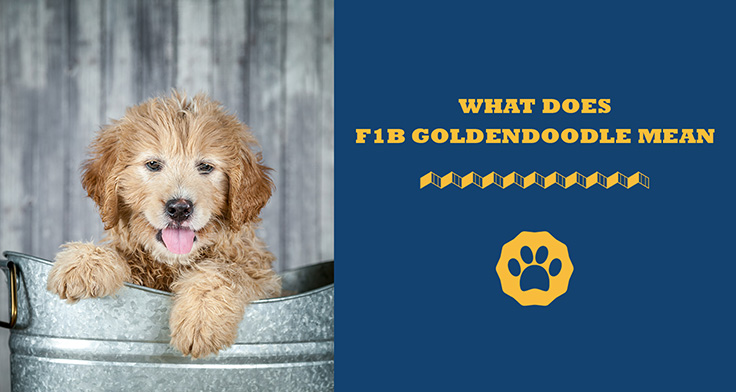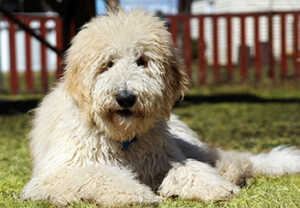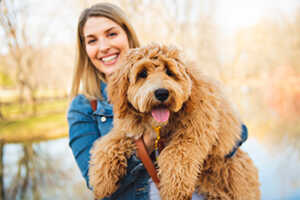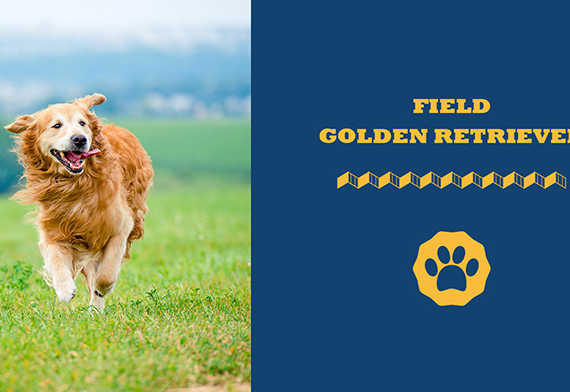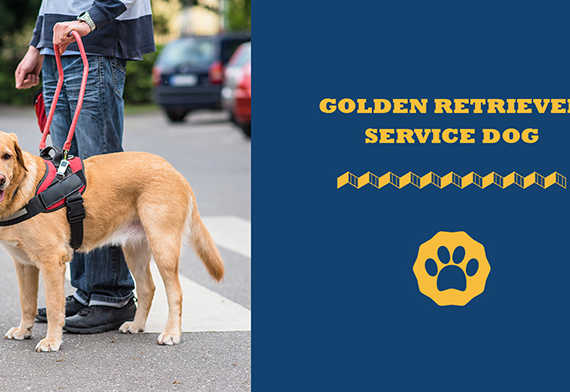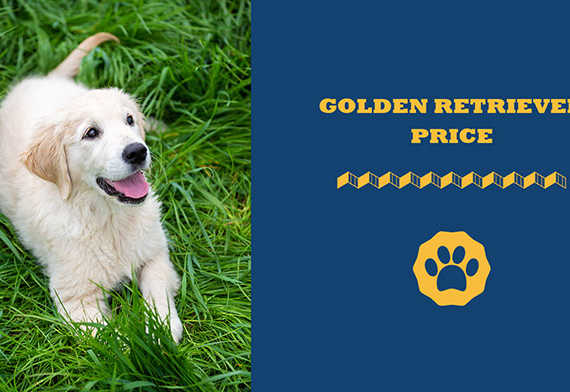There’s nothing straightforward about getting a goldendoodle! For starters, they’re divided up into generational classes known as F1 and F1B, F2 and F2B, and multi-generation, or F3.
What do these classes actually mean, and will an F1 look completely different than, say, an F2 doodle?
Goldendoodles come from a parental lineage that includes golden retrievers and poodles.
This cross-breeding results in a dog that has fur that doesn’t shed easily plus an easygoing and friendly personality that makes them ideal for families with children.
Additionally, goldendoodles make excellent service and therapy dogs with their gentle natures and capacity to learn the skills required for such jobs!
With so many positive attributes, it’s no wonder the doodle is a popular breed for many homes.
However, picking the right generation plays a huge role in the physical characteristics displayed by a doodle.
Your dog’s ancestry will also determine what health risks they could have.
Knowing the generational jargon will help you decide whether you should get an F1, F1B, F2, or F2B doodle. Let’s take a closer look below.
Goldendoodle Generations: What’s The Difference?
The different goldendoodle generations are determined by parental lineage and what percentage of a goldendoodle’s genes come from golden retrievers versus poodles.
Based on this ancestry percentage, the resulting doodle can have varying traits, such as shedding as much hair as a golden retriever and having a curly, wavy, or even straight coat.
An F1 goldendoodle will look quite different from a multigenerational doodle, while one is more prone to shedding, making the other type preferable for hypoallergenic owners.
Knowing the differences between the generation classes will help you pick the right dog for your home.
Understanding Goldendoodle Generations’ Labeling Standards
Breeders of this unique dog breed will typically label their pups according to the goldendoodle labeling standards.
Let’s unpack the jargon so it’s easier for you to understand when searching for a doodle for your home!
It Starts With The Letter “F”
The labeling of any goldendoodle generation starts with the letter “F,” which stands for “Filial Hybrid.”
A filial hybrid or F1 hybrid refers to the first generation of offspring that resulted from a crossing of two parental lines.
An F2 doodle is the second generation of offspring resulting from the cross-breeding of two dogs from the first filial generation.
An F3 doodle is the result of breeding an F1B to an F2B, two F1Bs, an F2 to an F2, or an F3 to an F3.
Finally, F3s are commonly referred to as multigenerational.
The Number After The Letter “F”
The letter “F” is always followed by a number that refers to the goldendoodle’s specific generation.
Doodle puppies labeled as F1 come from the first generation. Similarly, F2 goldendoodles come from the second generation.
An F1 goldendoodle is 50 percent golden retriever and 50 percent poodle with both parents being purebred.
F2 doodles are also half golden retriever and half poodle but are reproduced by hybrids and not purebreds.
F1 Followed By The Letter “B” Or “BB”
If you see the letter “B” after “F,” then you’re looking at a goldendoodle generation with a backcross.
This means a specific doodle generation was bred back to a purebred poodle.
Sometimes, but not often, “backcross” could also refer to being bred back to a golden retriever.
Backcross breeding allows a breeder to transfer a desirable trait from one dog breed into the favored genetics of another parent.
If the letter “F” is followed by “BB,” this indicates a specific generation was backcrossed twice with a poodle or golden retriever.
Goldendoodle F1B Meaning: What You Need To Know
Before understanding exactly what an F1B doodle is, it helps to first explore the F1 goldendoodle generation.
What Is An F1 Goldendoodle Generation?
An F1 doodle is the result of breeding a purebred golden retriever with a purebred poodle.
They have plush, loose-to-wavy fur with the potential for shedding. However, compared to other dog breeds, the F1 doodle’s shedding is comparatively minimal!
The genetic diversity of the F1 doodle can result in “hybrid vigor”, otherwise referred to as the heterosis effect in the scientific world.
Hybrid vigor in dogs can be defined as improved performance due to a specific biological function in the F1 cross.
This can result in health benefits by reducing certain risks often associated with purebreds.
Typical features of the F1 doodle generation include the following:
- Light to heavy shedding
- Straight, curly, or wavy coats
- Coats growing from three to five inches long
- Moderate to high grooming requirements
If you or someone in your family suffers from allergies caused by dog hair, it’s best to go with a doodle generation that sheds less.
F1B Goldendoodle Meaning: Exploring This Type Of Doodle
An F1B goldendoodle generation refers to a dog that is the result of a hybrid parent that has been bred back to a purebred breed, often the poodle.
Genetically, the dog is first generation, but the traits of the purebred have now been intensified.
Knowing which breeds are prone to shedding is important for some pet owners, and the golden retriever is one type that tends to shed a lot.
For this reason, breeders often choose to backcross to a purebred poodle to benefit from this breed’s low-shedding trait.
The majority of the litter inherits the poodle’s trait for reduced shedding.
Once the litter is a few weeks old, a breeder can run a coat test to determine which pups are low shedders. The F1B doodle is often a better pick for hypoallergenic homes.
Because the F1B goldendoodle is 75 percent poodle and 25 percent golden retriever, they have more of the former breed’s personality and appearance.
While they could present with a straight, wavy, or curly coat, they often have curlier coats compared to the F1 doodle.
Grooming your F1B goldendoodle with a slicker brush once or twice a week ensures they look great without losing their curly appearance.
You can use a metal comb to prevent tangled knots that could result in a matted coat. Having a grooming table can make the task much easier, too!
An F1BB goldendoodle, if backcrossed with a poodle, is 88 percent this breed and 12 percent golden retriever.
The result is a litter that mostly resembles the poodle’s curly coat and reduced shedding traits.
What Is The Best Goldendoodle Generation For You?
A number of factors will determine which goldendoodle generation is best for you.
However, for allergy sufferers, the F1B, F2B, or F1BB types are the best generations most suitable for hypoallergenic environments.
If you prefer your doodle to have a wavy or curly coat and more poodle personality than a golden retriever, the F1B is your best pick.
When looking at the cost of adopting a goldendoodle, the F1B doodle is often more affordable than the F1 with purebred traits.
The hybrid vigor of the F1 goldendoodle is slightly lower compared to the F1 generation, but it’s still a healthy generation overall!
Frequently Asked Questions (FAQs)
Are F1B goldendoodles good dogs?
F1B goldendoodles are wonderful dogs with a combination of good personality traits and hypoallergenic natures.
They’re most suitable for families with children and allergy sufferers as well as being excellent service or therapy dogs.
F1B goldendoodles respond well to training with their eager-to-please personalities.
How big do F1B goldendoodles get?
The F1B goldendoodle commonly comes in two sizes – miniature and standard.
A F1B miniature doodle can weigh between 20 to 40 pounds while standing 16 to 18 inches tall.
The standard F1B goldendoodle typically weighs between 40 to 85 pounds and stands 19 to 25 inches tall.
What health problems do F1B goldendoodles have?
The F1B doodle can suffer from conditions such as hip dysplasia, Addison’s disease, cataracts, and glaucoma.
They can also be prone to a skin condition called sebaceous adenitis and a heart problem known as subvalvular aortic stenosis.
How long do F1B goldendoodles live?
Goldendoodles have a life expectancy of around 10 to 15 years. Poodles have a lifespan of 12 to 15 years, while golden retrievers can live between 10 to 12 years.
With the F1B doodle having more poodle than golden retriever genes, their lifespan can be up to 15 years.
What does F1B mean?
F1B means first-generation backcross. In goldendoodle breeding terminology, this refers to being bred back to a purebred breed, most often the poodle.
Checking with the breeder will confirm if F1B refers to a purebred poodle or golden retriever.
F1B Goldendoodles: Conclusion
Knowing the different goldendoodle generations matters a whole lot if you’re looking for a dog with a certain appearance and personality.
It also makes a huge difference when you want a doodle that hardly sheds, if at all! The main attractive traits of an F1B goldendoodle include:
- Minimal shedding
- Poodle personality and appearance
- Curly or wavy coat
In short, the F1B goldendoodle is an allergy sufferer pet owner’s dream come true with its hypoallergenic nature. You get the doodle you love without the shed!
Are you looking to get a goldendoodle or do you already have one?
Tell us about your experiences in the comment section below.

